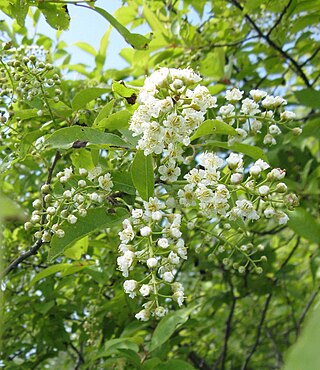
Prunus virginiana, commonly called bitter-berry, chokecherry, Virginia bird cherry, and western chokecherry, is a species of bird cherry native to North America.
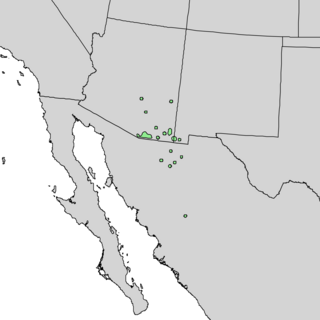
Quercus toumeyi, the Toumey oak, is a North American species of tree in the beech family. It is found in northwestern Mexico and the southwestern United States. It grows in Sonora, Chihuahua, Arizona, New Mexico, and the extreme westernmost tip of Texas.

Yucca × schottii is a plant species in the genus Yucca, native to southern Arizona, southwestern New Mexico, and the northern parts of Sonora and Chihuahua. The common names are Schott's yucca, hoary yucca, and mountain yucca. The "×" in the name indicates that this is a nothospecies, regarded as being a natural hybrid between two other species. In this case, Yucca × schottii is believed to have originated as a hybrid between Y. baccata and Y. madrensis. Yucca × schottii is firmly established and does reproduce freely in the wild.
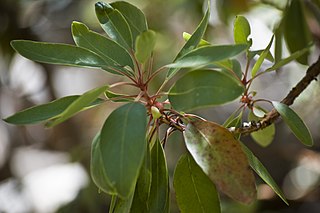
Arbutus arizonica, commonly known as Arizona madrone, is a tree species in the heath family that is native to the southwestern United States and northwestern Mexico. Its range extends along the Sierra Madre Occidental cordillera from the Madrean Sky Islands of southeastern Arizona and southwestern New Mexico south as far as Jalisco. It has been found in Sonora, Chihuahua, Durango, and Sinaloa, with one isolated population in Tamaulipas.

Platanus wrightii, the Arizona sycamore, is a sycamore tree native to Arizona and New Mexico with its range extending south into the Mexican states of Sonora, Chihuahua, and Sinaloa.

Hymenocallis pimana is a member of the genus Hymenocallis, in the family Amaryllidaceae. Common name in English is Pima spider-lily; in Spanish it is cebollín. It is endemic to a small mountainous region in the Sierra Madre Occidental, straddling the Mexican states of Chihuahua and Sonora. Many of the people of the region are of the indigenous group known as the Mountain Pima or Pima Bajo.
Pectis pimana is an herbaceous plant in the family Asteraceae. It is endemic to a mountainous area in the Sierra Madre Occidental, in the Mexican State of Chihuahua. Type locale is the village of Nabogame, 18 km northwest of Yepachic and about 10 km east of the state line with Sonora. Most of the inhabitants of Nabogame are of the indigenous ethnic group known as the Mountain Pima or Pima Bajo; the specific epithet "pimana" was chosen in their honor.
Rubus sierrae is a small Mexican species of shrub in the genus Rubus, family Rosaceae. It is known from a single collection from near the village of Nabogame, Chihuahua, Mexico, in the Sierra Madre Occidental approximately 18 km northwest of Yepachic. The specimen was collected in riparian forest dominated by Acer grandidentatum Nutt. and Cupressus lusitanica.

Passiflora bryonioides, the cupped passionflower, is a plant in the genus Passiflora, family Passifloraceae. It is native to northern Mexico and the south-western United States (Arizona).
Physalis caudella, the southwestern groundcherry or tomatillo chiquito, is a plant in the family Solanaceae, native to Arizona, Sonora and Chihuahua. The purple-green fruits are small but edible.

Yucca grandifloraGentry is a plant in the family Asparagaceae, native to the Sierra Madre Occidental in the Mexican states of Chihuahua and Sonora.
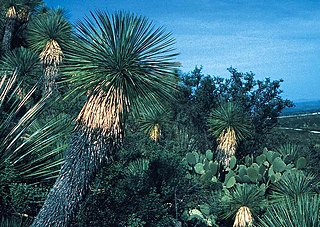
Yucca linearifolia is a plant species in the family Asparagaceae, native to the Chihuahuan Desert in the Mexican states of Coahuila and Nuevo Leon. It is a tree-like perennial up to 3.5 m tall, with narrow, denticulate leaves and fleshy fruits.

Yepáchic, sometimes spelled Yepáchi, is a community in the western part of the Mexican State of Chihuahua, approximately 10 km (6.2 mi) east of the boundary with the State of Sonora. It is located in the Municipio de Temósachic at an altitude of 1,780 meters (5,840 ft) in the Sierra Madre Occidental. Many of the people of the region are members of the indigenous ethnic group called Mountain Pima or the Pima Bajo. They are related to the Pima and Papago of Arizona and northern Sonora, speaking a similar but distinct language.
Solidago juliae, known as Julia's goldenrod, is a plant native to central and western Texas, as well as southern Arizona, Chihuahua, Coahuila and Nuevo León. It occurs in grasslands, woodlands, and on freshwater shores.
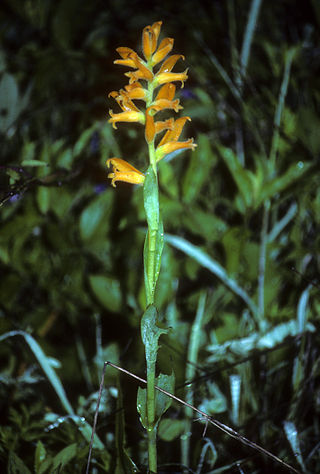
Dichromanthus aurantiacus is a terrestrial species of orchid. It is native to much of Mexico, Guatemala, Honduras and El Salvador. It is a common and conspicuous weed in fallow fields in much of the region.
Brickellia oreithales is a Mexican species of flowering plants in the family Asteraceae. It is native to northern and western Mexico, states of Sonora, Chihuahua, Durango, Jalisco, and Zacatecas.
Carphochaete wislizeni is a species of Mexican flowering plants in the family Asteraceae. They are native to Chihuahua, Sonora, and Durango in northern Mexico.

Dieteria asteroides, the fall tansyaster, is a North American species of plants in the sunflower family. It is native to the southwestern United States and northern Mexico.
Erigeron sceptrifer is a North American species of flowering plant in the family Asteraceae known by the common name scepter-bearing fleabane. It has been found in northern Mexico and the southeastern United States.
Helenium laciniatum is a North American perennial plant in the sunflower family. It is found in the states of Sinaloa and Sonora in northwestern Mexico.












